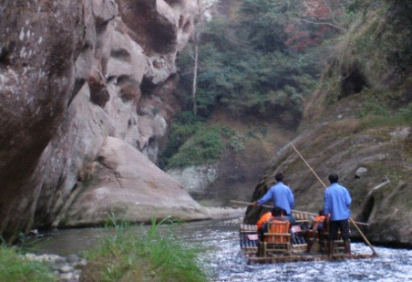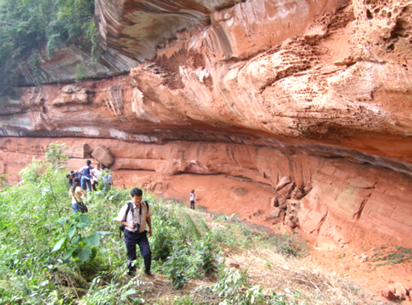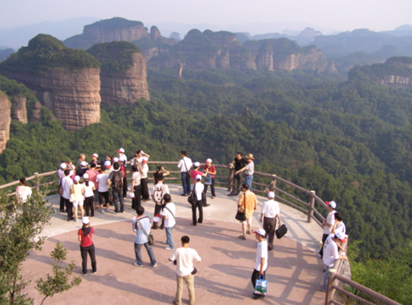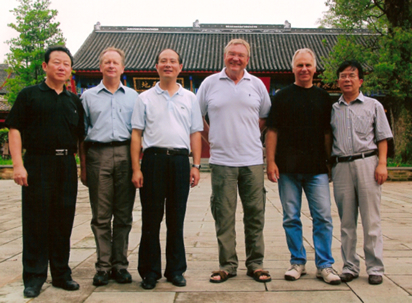Staff member plays a leading role in defining a new world landscape type
 |
Dr Chris Wood on his latest visit to China |
It might be thought that there is little more to be discovered about the major types of physical landscapes of the world, but a recent important international symposium attended by Chris Wood from Conservation Sciences drew attention for the first time ever to the world's 'red bed' landscapes and advocated in future they be known as 'Danxia'. Red beds is a term signifying rocks made up of red-coloured sediments laid down in a terrestrial (as opposed to marine) environment. These types of beds form such iconic places as Ayers Rock in Australia, Monument Valley in USA, Meteora in Greece, and Petra in Jordan.
The term 'Danxia' to describe red bed landscapes was first used by Chinese scholars more than 80 years ago. The name is taken from Danxiashan (Danxia Mountain), which now serves as the type locality in China. China has in fact more than 760 Danxia sites scattered across the country, although the best are in the SE provinces, developed under a warm, humid, sub-monsoonal climate. These are not only spectacular mountain landscapes, but each has many elements of their geomorphology disinct from those of other sites. All are formed from red beds laid down in the late Jurassic-Cretaceous period, in extremely active, fault-bound basins. Because of the dynamic tectonic environment, the massive sequences of sandstones, conglomerates and siltstones have been broken into an extremely dense network of criss-crossing secondary faults and joints. Today, in the warm, humid climate, abundant rainfall has exploited the fracture network, and in the early stage of landscape dissection, stream erosion has cut deep, narrow clefts (sometimes tens of metres deep, hundreds of meters long, and only body width) and canyons. In more mature sites, valleys have widened through toppling and rock fall to present huge red cliffs bounding narrow ridges or small plateau remnants (mesas). In other sites slopes have become rounded under the action of weathering to form large areas of cone- or bell-shaped mountains, and in yet other sites only vestiges of the former red bed deposits remain as isolated towers.
It was the desire of Chinese geologists and geomorphologists to share the science and heritage of Danxia with the rest of the world that provided the stimulus for this first international Danxia symposium. The event was held on the 26-29 May at Shaoguan, Guangdong Province, just outside of the Danxiashan national park. Supported by the International Union of Geological Sciences, the International Association of Geomorphologists, and the Geological and Geographical Societies of China, the symposium attracted 154 scientists from 15 different countries.
Chris Wood has been working with Chinese geologists and geomorphologists for more than 3 years in efforts to better define the China Danxia and to seek international comparisons. He played a leading role in the organisation of the symposium, presented several papers, chaired the plenory session, and helped draft the symposium's concluding Declaration. Amongst other things, the Declaration recognised that the Danxia of SE China presented a remarkable and unique assemblage of geomorphological landscapes, rivalled no-where else in the world. The Declaration also called for wider recognition of the China Danxia, possible international use of the term 'Danxia' to describe all red bed landscapes, and the strengthening of international co-operation in the scientific study of the phenomenon. Papers from the symposium are to be published as a book later this year.

The Danxia mountains of Langshan, Hunan Province

One of many deep canyons at Taining, Fujian Province

Delegates investigating red beds and honeycombe weathering, Danxiashan, Guangdong Province

Delegates meet the media at Danxiashan, Guangdong Province

Foguangyan waterfall, Chishui, Guizhou Province

Danxia advisers with the Mayor of Yintan City (left to right: Prof. Peng Hua (leading Danxia academic), Paul Dingwall (IUCN), the Mayor, Dr Wolfgang Eder (former Director of Earth Sciences, UNESCO), Dr Chris Wood (BU), Wang Xiaoliang (Deputy Director, Danxia World Heritage project)
17/06/09
